Dan Mask Marquetry-Part 1
Somewhere. That’s where everyone has to start. Earlier, I hinted about a marquetry project that I want to do. First, I need to do a practice piece. This is the warm-up.
Marquetry is a decorative art typically associated with carpentry and furniture-making. Thin sheets of wood, metal, shell, and semiprecious materials are cut into intricate patterns. The design is glued to the flat surfaces of furniture. The art has been treasured for centuries. It has also been protected and highly regulated by art guilds in France, Italy, England, eastern Europe, and even Asia.
A handful of marquetry masters dominated the craft for centuries. Their works are highly desired and treasured in private collections and public institutions.
I didn’t like it… then
When I was a young girl, I thought that furniture and art work that featured marquetry images were unattractive, maybe even ugly. If the work was not straightforward with lines, blocks, and angles, I just did not like it. I associated it with old things, and old ways of thinking.
Now that I have a bit more knowledge, my judgment is less harsh. I reserve it solely for the subject matter. A lot of the images depicted in marquetry do not apply to me. Yes, flowers are a sight to behold, but a mass of them on furniture panels is too fussy for me. I would like it better if some of the images were more to my liking. That’s all.
Let’s make something I like
I decided that I’d create something different. This project will be more to my taste and the subject will be relevant to me. There are a number of approaches to doing marquetry. I’ll use what I know and what I learn along the way to complete the project.
At the end of this journey, on the mastery scale, I hope to achieve a bit of competence in marquetry. The bonus will be that I will learn more about myself and have fun bringing my idea to life.
The Cartoon
My marquetry model drawing or cartoon is a humble representation in the style of the Dan mask. The Dan people lived on the west coast of Africa – Côte d’Ivoire.
African masks and their ancient uses have intrigued social scientists for centuries. Masks symbolize and personify significant aspects and mysteries of communal life in African villages. The masks were also used in ceremonies marking rites of passage for young males.
The Dan masks are distinguished by long oval faces, pointed chins, slotted narrow eyes, and oversized open mouths.
Some of the masks have holes for inserting long strands of straw that represented hair and beards.

A short list of tools
In addition to a steady hand, here are the tools and materials I have in my shop and may be using:
- veneer
- veneer hammer
- hide glue
- glue pot
- base or core wood
- veneer tape
- veneer saw
- fret saw
- craft knife
- fret saw table
Assembling the marquetry packet
A copy of the cartoon is glued to the top of a piece of slightly oversized gray board.
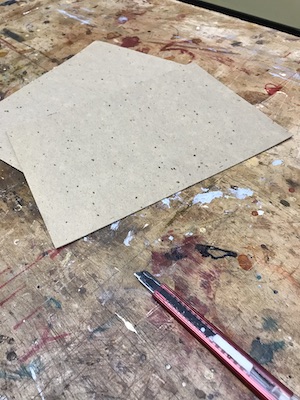
It will serve as the cutting template and saw guide so I don’t cut aimlessly. The glued cartoon will be used up in the process so I made 2 copies to show me how it goes back together once the pieces are cut out. I can stage the pieces during and after the cutting.
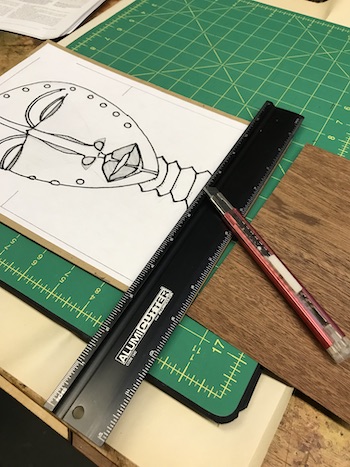
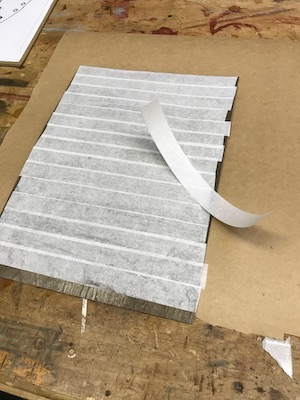
Creating the marquetry puzzle
The areas that I want to highlight on the cartoon are cut from various species of wood veneer. Blocks or pieces of the veneer will be cut to correspond to their sizes on the cartoon. I cut them oversize, cover all of them (even the tiniest pieces) with moistened veneer tape, and let them dry. A heavy weight and a piece of plywood is used as a “press”. This keeps the wetted veneers from contracting or curling.
I worked fast and steady here because the veneer tape dries fast. The thin veneer reacts by curling immediately. Then, I left all of the pieces to dry overnight under the weighted plywood.
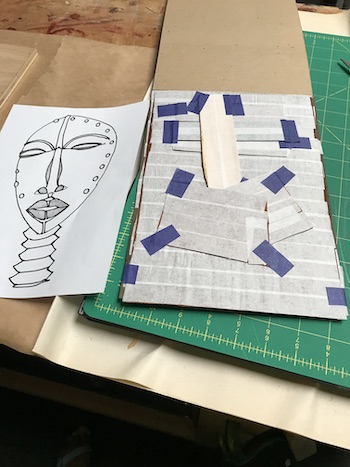
a copy of the design to help in the layout of the veneer pieces. That
blue painters tape is holding down the smaller taped veneer blocks.
Now, the dried veneer pieces are built up like ingredients in a sandwich. The background veneer is laid on the bottom gray cover. Then, the next layer of veneer for the mask face is placed on top. After that the relatively smaller blocks of veneer for the mouth, nose, and eyes, etc. are laid on top. The placement corresponds to their positions on the cartoon.
The built-up packet
Yes, there is a lot of overlapping of veneer blocks and pieces and uneven buildup throughout the packet. The end result is as follows:
- the cover – cartoon glued to the top gray board,
- five layers of veneer and veneer blocks representing the features to be cut out,
- a lot of veneer tape and blue tape throughout,
- the bottom book board.
It feels just like a lumpy sandwich. The blue tape applied where needed keeps the veneer blocks in position. Importantly, it keeps the pieces from shifting when sawing the packet.
The entire packet or stack will be cut – the drawing, cardboard, veneer, and tape. Afterwards, the relevant veneer piece for a specific feature will be fished out of each cut stack.
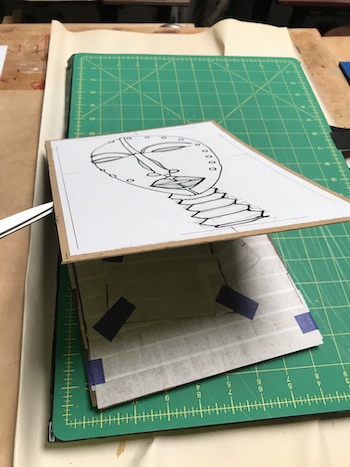
After all that taping, the packet is ready to be pinned and sawn. To be continued…
🐞 Shirley J
—
Next time: Dan Mask Marquetry, part 2, The Packet
